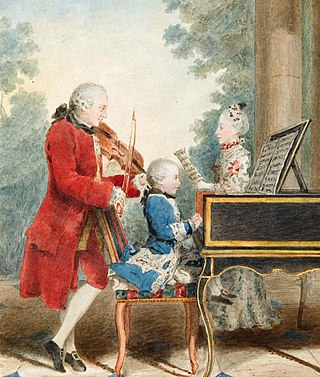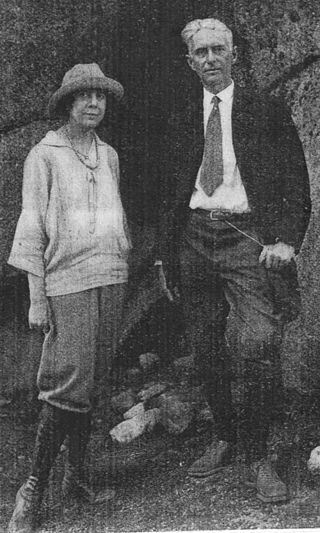Related Research Articles

The Classical period was an era of classical music between roughly 1750 and 1820.
Impressionism in music was a movement among various composers in Western classical music whose music focuses on mood and atmosphere, "conveying the moods and emotions aroused by the subject rather than a detailed tone‐picture". "Impressionism" is a philosophical and aesthetic term borrowed from late 19th-century French painting after Monet's Impression, Sunrise. Composers were labeled Impressionists by analogy to the Impressionist painters who use starkly contrasting colors, effect of light on an object, blurry foreground and background, flattening perspective, etc. to make the observer focus their attention on the overall impression.

Romantic music is a stylistic movement in Western Classical music associated with the period of the 19th century commonly referred to as the Romantic era. It is closely related to the broader concept of Romanticism—the intellectual, artistic and literary movement that became prominent in Western culture from approximately 1798 until 1837.

Sonata, in music, literally means a piece played as opposed to a cantata, a piece sung. The term evolved through the history of music, designating a variety of forms until the Classical era, when it took on increasing importance. Sonata is a vague term, with varying meanings depending on the context and time period. By the early 19th century, it came to represent a principle of composing large-scale works. It was applied to most instrumental genres and regarded—alongside the fugue—as one of two fundamental methods of organizing, interpreting and analyzing concert music. Though the musical style of sonatas has changed since the Classical era, most 20th- and 21st-century sonatas still maintain the same structure.
Events in the year 1883 in music.
Ottaviano Petrucci was an Italian printer. His Harmonice Musices Odhecaton, a collection of chansons printed in 1501, is commonly misidentified as the first book of sheet music printed from movable type. Actually that distinction belongs to the Roman printer Ulrich Han's Missale Romanum of 1476. Nevertheless, Petrucci's later work was extraordinary for the complexity of his white mensural notation and the smallness of his font, and he did in fact print the first book of polyphony using movable type. He also published numerous works by the most highly regarded composers of the Renaissance, including Josquin des Prez and Antoine Brumel.
Léonin was the first known significant composer of polyphonic organum. He was probably French, probably lived and worked in Paris at the Notre Dame Cathedral and was the earliest member of the Notre Dame school of polyphony and the ars antiqua style who is known by name. The name Léonin is derived from "Leoninus," which is the Latin diminutive of the name Leo; therefore it is likely that Léonin's given French name was Léo.
The Florentine Camerata, also known as the Camerata de' Bardi, were a group of humanists, musicians, poets and intellectuals in late Renaissance Florence who gathered under the patronage of Count Giovanni de' Bardi to discuss and guide trends in the arts, especially music and drama. They met at the house of Giovanni de' Bardi, and their gatherings had the reputation of having all the most famous men of Florence as frequent guests. After first meeting in 1573, the activity of the Camerata reached its height between 1577 and 1582. While propounding a revival of the Greek dramatic style, the Camerata's musical experiments led to the development of the stile recitativo. In this way it facilitated the composition of dramatic music and the development of opera.

Nicola Vicentino was an Italian music theorist and composer of the Renaissance. He was one of the most progressive musicians of the age, inventing, among other things, a microtonal keyboard.

In music theory, the recapitulation is one of the sections of a movement written in sonata form. The recapitulation occurs after the movement's development section, and typically presents once more the musical themes from the movement's exposition. This material is most often recapitulated in the tonic key of the movement, in such a way that it reaffirms that key as the movement's home key.
The modern state of Italy did not come into being until 1861, though the roots of music on the Italian Peninsula can be traced back to the music of ancient Rome. However, the underpinnings of much modern Italian music come from the Middle Ages.

Classical music generally refers to the art music of the Western world, considered to be distinct from Western folk music or popular music traditions. It is sometimes distinguished as Western classical music, as the term "classical music" also applies to non-Western art music. Classical music is often characterized by formality and complexity in its musical form and harmonic organization, particularly with the use of polyphony. Since at least the ninth century it has been primarily a written tradition, spawning a sophisticated notational system, as well as accompanying literature in analytical, critical, historiographical, musicological and philosophical practices. A foundational component of Western culture, classical music is frequently seen from the perspective of individual or groups of composers, whose compositions, personalities and beliefs have fundamentally shaped its history.

Morpheus is a composition for viola and piano by the English composer and violist Rebecca Clarke. It was written in 1917 when Clarke was pursuing a performing career in the United States. The piece shows off the impressionistic musical language Clarke had developed, modeled on the music of Claude Debussy and Ralph Vaughan Williams, that is also apparent in her Viola Sonata. The harmonies are ethereal and otherworldly; the title is the name of a Greek god, who was especially associated with sleep and dreams.
Susanna Nerantzi was a Greek pianist and composer, perhaps born in Zakynthos, Greece. She is the earliest recorded modern Greek female composer. She studied piano and composition in Corfu under Nikolaos Mantzaros and composed works which were published by Francesco Lucca of Milan in 1839.
Claire Renard is a French composer and multimedia artist.
Marielli Sfakianaki-Manolidou is a Greek writer, singer and composer.
Graciela Paraskevaidis was an Argentine writer and composer of Greek ancestry who lived and worked in Uruguay.

Fannie Charles Dillon was an American pianist, music educator and composer.
Lila Lalauni was a Greek pianist and composer. She was born in Athens, the granddaughter of composer Timotheos Xanthopoulos. She studied piano at the Vienna Academy and then composition with Robert Konta. She made her debut as a concert pianist in Vienna in about 1930, and graduated from the academy in 1934. She continued her studies with Marcel Dupre in Paris, and became known internationally as a pianist. Her vision failed in her later life.
References
- ↑ Sadie, Julie Anne; Samuel, Rhian (1994). The Norton/Grove dictionary of women composers. W. W. Norton & Company. ISBN 9780393034875 . Retrieved 6 December 2010.